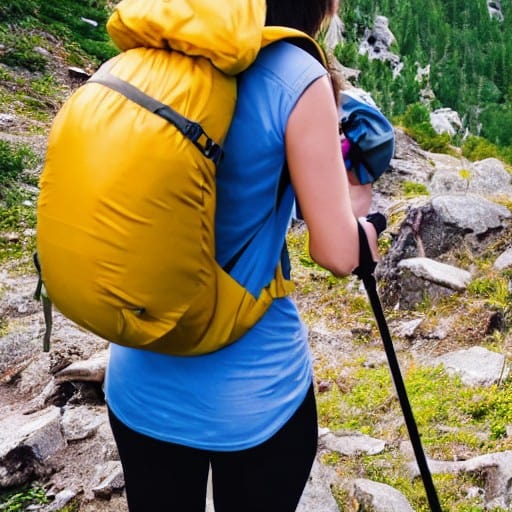Table of Contents
Some links on posts are affiliate links and will earn us a commission from qualifying purchases
Hiking is a popular activity cherished by outdoor enthusiasts who wish to experience the beauty of nature, exercise, and explore the great outdoors. After all, who wouldn’t want to escape the hustle and bustle of everyday life and seek solace amidst the tranquility of nature? While this activity may be seemingly harmless, the tools used during hiking, such as hiking poles, may, in fact, have a significant environmental impact on the delicate ecosystems they pass through. This blog post seeks to examine the potential ecological effects of hiking pole use, including trail erosion, vegetation damage, and potential harm to small creatures, while also discussing recommendations for more sustainable trekking practices.
The Growing Popularity of Hiking Poles
Hiking poles have been used for centuries by hikers and mountaineers. In recent years, they have become increasingly popular among outdoor enthusiasts due to the many benefits they provide. Hiking poles are not only great for providing stability and balance, but they also help distribute the weight of heavy backpacks more evenly, thus reducing the strain on the body. Additionally, they can help reduce the impact that hiking has on the environment by reducing footprints.
However, as with any new trend, concerns have been raised about the potential ecological effects of hiking poles on the environment. Some studies have suggested that using hiking poles can cause erosion and damage to delicate ecosystems. When used improperly, hiking poles can damage vegetation and soil, disrupting ecosystems that require a delicate balance to thrive.
To help mitigate these environmental concerns, several hiking pole manufacturers now produce eco-friendly hiking poles made from sustainable materials that are designed to minimize their impact on the environment. Additionally, hikers are encouraged to follow Leave No Trace principles when using hiking poles, which includes minimizing impact and leaving areas as they found them.
Overall, while the use of hiking poles has become increasingly popular among hikers, it is important to be aware of their potential environmental impact and to take necessary precautions to minimize their impact on the natural world. As with any outdoor activity, it’s essential to practice responsible outdoor recreation to ensure that future generations can enjoy the same natural beauty that we enjoy today.
Trail Erosion and Vegetation Damage
The use of hiking poles can have a more far-reaching impact on the environment than one might expect. As hikers use their poles to propel and support themselves as they traverse trails, their pole tips push into the soil, resulting in an increase in soil compaction and displacement, two key contributors to erosion. Over time, continued and repeated use of hiking poles can lead to the formation of ruts in the trail surface, further exacerbating erosion rates.
In addition to increasing soil compaction and displacement, this heightened rate of erosion affects surrounding vegetation through water runoff. This can be especially pronounced in areas with higher elevations or steeper inclines where water accumulates quickly and is funneled towards lower-lying areas. As a result, root systems become exposed, leaving them vulnerable to further disruption by heavy rainfall events or snowmelt. Such effects not only diminish biodiversity but also alter entire ecosystems due to habitat degradation caused by excessive erosion.
Therefore, it is important for hikers to take extra care when using hiking poles so as not to leave behind lasting negative impacts on the environment. To reduce their overall footprint on trails, hikers should strive to limit pole contact with the ground through careful weight distribution and choose softer pole tips made from materials such as rubber or silicone. By doing so, we can help protect our beloved trails — allowing us all to enjoy nature without leaving behind an unsustainable legacy.
Effects on Small Creatures and Microhabitats
Hiking poles have become increasingly popular in recent years as a useful tool to maintain balance and reduce joint stress during long hikes. However, the unintended consequences of their use on the natural environment have been overlooked. It is important to note that hiking poles can cause harm to both macro and microorganisms and their habitats along hiking trails.
As hikers walk along a trail, they may inadvertently strike small organisms, such as insects, amphibians, and reptiles, causing injury or displacement. For example, the legs of fern frogs and newts can be easily severed by a hiking pole strike. Such events can cause disruption or even death to these creatures, leading to ecological imbalances that could affect the entire food chain.
Additionally, the constant impact of hiking poles on the ground may lead to the degradation or destruction of microhabitats that support these organisms. Microhabitats, such as mosses, leaf litter, or decaying logs, are fragile ecosystems where these organisms thrive. Hiking poles can destroy these habitats, which can lead to the reduction or even loss of biodiversity in the area.
It is not just the harm caused to the various organisms but also the impact on the ecosystem that is worth noting. The damage caused to microhabitats can have cascading effects on the rest of the ecosystem. Microhabitats provide food and shelter for larger organisms, such as birds and mammals. The nutrients they provide help sustain soil, and their complex structure supports beneficial bacteria that maintain soil health. The damage to these habitats, therefore, has far-reaching impacts on the overall health of the ecosystem.
In conclusion, hikers should be mindful of their use of hiking poles and take steps to minimize harm to the natural environment. This could involve walking softly or avoiding trailside vegetation. The ecosystem is complex and interconnected. It is vital that we take steps to minimize our impact on it as we enjoy the benefits it provides us.
Recommendations for More Sustainable Trekking Practices
So, are hiking poles a friend or foe to delicate ecosystems? The answer lies somewhere in between. While hiking poles do have an undeniable impact on the environment, hikers can adopt more sustainable practices to minimize their ecological footprint. Here are some recommendations:
- Educate yourself on Leave No Trace principles: Familiarize yourself with the Leave No Trace guidelines, which provide best practices for sustainable hiking, such as staying on established trails, avoiding fragile environments, and respecting wildlife.
- Use pole tips with rubber tips or baskets: Equip your hiking poles with rubber tips or baskets to reduce the direct impact of the pole into the ground, thus reducing soil compaction and erosion.
- Be mindful of where you place your hiking poles: Avoid placing your hiking poles into delicate vegetation or small critters’ habitats. Observe where you place your poles, and make a conscious effort to avoid causing unnecessary harm.
- Keep in mind that pole usage may not be beneficial at all times: Determine the necessity of using your hiking poles for a particular hike. In some cases, performing a hike without poles can help to reduce their environmental impact.
Conclusion – The Environmental Impact of Hiking Poles
In conclusion, hiking poles can have significant ecological effects on the environment, including trail erosion, vegetation damage, and potential harm to small creatures. Nevertheless, by adopting more sustainable trekking practices and being mindful of their actions, hikers can continue to enjoy this popular activity while minimizing the environmental impact of their hiking poles. Ultimately, it is everyone’s responsibility to nurture and protect the ecosystems they traverse to ensure that future generations can enjoy and appreciate the beauty of nature, too. Happy hiking!
Recent Posts
Choosing the Perfect Hiking Poles: A Comprehensive Guide to Features and Designs
Hiking is a fantastic way to stay healthy, explore the great outdoors, and challenge yourself physically and mentally. Along with appropriate footwear, backpack, and clothing, a reliable pair of...
I've been wondering about buying some walking poles for a while, but don't really know anyone who uses them. So I've had no-one to ask about them in person and as such had to do my own...


